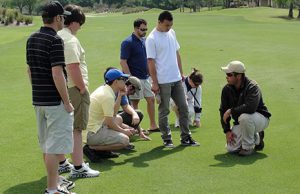Turf pros, you have fought for years to try to get enough downtime on your sports turf to really work on making big improvements. Now, with school and city leagues cancelled, is the perfect time. The grass has
greened up and is needing mowing. The soil temperatures are up. We have gotten a decent rain with more predicted. So, plan to make some of those much-needed improvements in May.
If you haven’t submitted soil samples, start with getting that baseline information. All the labs are open and working, including UF. Sampling kits and instructions are available at: https://soilslab.ifas.ufl.edu/ESTL%20Tests.asp.
Get out there and fix all the irrigation system imperfections. Knowing the water output and uniformity can make all the difference in the turf appearance and response to fertilizers, not to mention reducing disease pressure. Make sure you have head-to-head coverage, not the “almost” head-to-head coverage that cheats a few feet here and there. Calibrate each zone to determine how much time it takes to deliver ¾ inch of water. Watch this video for more information: https://www.youtube.com/watch?v=W_wn-hwLNtg
Take this time to accurately measure the areas that will need fertilizing and calibrate your spreader to you and the product. Set the application schedule for the rest of the year. Accomplishing this now when you’re not so pressed for time will pay off. Remember with rotary spreaders, fertilizer distribution is not uniform. More granules fall in the middle of the pass than along the outer edges. To achieve uniformity, check that the tire is just inside the track from the previous pass and that the granules are reaching the previous track. Additionally, apply in two directions.
How about reducing compaction and improving the overall soil conditions? That’s the one project you’ve been wanting to do for many seasons. Physical penetration of the soil improves air, water, and nutrient movement within the root zone. This is especially important for high traffic areas. A hollow tine, or core, aerator pulls soil cores from a 2-6 -inch depth. Cores can be removed or dried on the surface and reincorporated using a drag mat. If thatch is an issue, consider vertical mowing to cut into the turf runners and loosen the dead tissue layer. Then, rake, rake and rake! The grass will look rough for a while during the recovery but will be much healthier in the long run.
When you get your soil test results back, they will identify nutrient deficiencies and recommend lime and fertilizer for the year. Lime should only be applied in accordance with the recommendations on soil test results. Over-application can take years to correct. Split applications of the annual required rate will allow for more adjustment. Nitrogen influences color and many growth factors. Application rate recommendations are based on research-driven requirements for each grass type. However, nitrogen comes in quick-release and/or slow-release. Quick release products are water soluble and cause a turf response in a week or less but can evaporate or burn. Application should always be followed by ¼ inch of irrigation to get the most benefit. Slow release products are water insoluble and provide a gradual, consistent turf response over a 3-10-week period. They require warm, moist soil with microbes in order to release nitrogen. Most of the available fertilizers will have a combination of both quick and slow release components. That way there is an immediate green up with long lasting color. Bermudagrass needs 0.5-1 pound of soluble N/ 1,000 sq. ft. to get going in the spring.
You’ve been saying, “We need to get some of these big tasks done, but just can’t find the time when no one is on the field.” Here’s your chance.
- Florida Certified Horticulture Professional Training - December 3, 2021
- Gulf States Horticulture Expo 2022 - December 3, 2021
- Empty Fields? Time to tackle turfgrass improvement projects! - April 27, 2020
